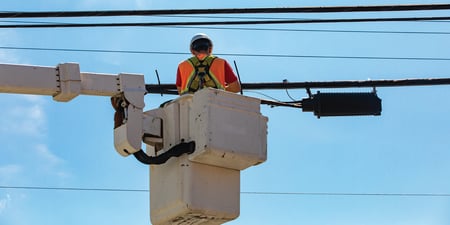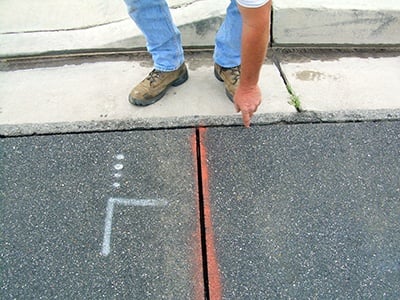 Careful planning is crucial if a Fiber to the Premises (FTTP) installation is to be a success. It begins with choosing your architecture, and in a previous blog, we looked at the advantages and disadvantages of PON and P2P architectures. This was part of the Complete Guide to Fiber to the Premises eBook, a free download that covers the factors you need to take into account when making choices for your implementation.
Careful planning is crucial if a Fiber to the Premises (FTTP) installation is to be a success. It begins with choosing your architecture, and in a previous blog, we looked at the advantages and disadvantages of PON and P2P architectures. This was part of the Complete Guide to Fiber to the Premises eBook, a free download that covers the factors you need to take into account when making choices for your implementation.
After choosing an architecture, the next challenge is cost-effectively deploying last drop connections. The first factors to take into account revolve around the terrain and environment, which affect whether to go for a buried or aerial deployment. Let’s look at these in more detail:
Aerial Fiber Cable Deployment
Aerial cables and ducts are some of the most cost-effective methods of deploying to the customer as operators can use existing pole infrastructure, avoiding the need to dig up roads to bury cables or ducts.
However, aerial cable is fragile. It will strain, sag, and eventually break if it is exposed to extreme wind, large temperature variation, and ice loading. Bird damage can be an issue and if it is close to electric cables it has to be properly insulated. In addition, calculations on the strength of both the cable and poles need to be taken into account when determining span lengths.
However, if poles and cables need to be made stronger, this has a big impact on costs and time. In urban areas, this can often cause issues with local planning authorities.
This means that aerial is more suited to areas with existing pole networks or rural environments without urban restrictions. It is a good option for the final drop providing cheap labor and material can be obtained.
Buried Fiber Deployment
Most local authorities and customers prefer their services, including fiber cables, to be installed underground. Buried fiber deployments are immune to wind and ice damage as they are buried below the layer where the soil freezes. This means that underground deployments is often at least 10 times more reliable than aerial routes, especially where poor weather is common.
But there are some downsides. Cable needs to be buried deep in the ground to protect it from accidental damage – and the deeper an operator has to dig the more costly it is. Unforeseen obstacles such as tree roots can dramatically add to costs. If a buried direct cable is broken, it is expensive to repair. Unlike cable in duct solutions, buried direct cable cannot be removed and replaced because it tends to be firmly anchored into the ground.
Dealing with Different Terrain
The geology of a landscape – be it rural or urban – will directly determine whether buried or aerial fiber deployments are most suitable for the last drop.
If the terrain is rocky, for example, it won’t be cost-effective to put poles in the ground to carry aerial cable. So unless there is existing infrastructure in the ground, the operator will have to create a shallow trench and install a buried cable. In this case, given its proximity to the surface, the cable will need to be sufficiently robust to handle heavy contact.
Sandy soils are far easier to manipulate. They can also be excavated by hand and it is easy to create flat bottoms in trenches, making sandy soil perfect for cable and duct solutions.
Clay is much harder to dig and can contain rocky particles. Stones can impinge on both the cable and duct and cause damage after burial. Operators can circumvent these challenges by digging deep trenches and using thicker walled cables or ducts.
However, the downside is obviously cost – deep trenches are expensive to excavate and thicker cable costs more.
Also, within an urban setting, it makes sense to use existing infrastructure wherever possible. After all, drilling into a hard surface like asphalt or tarmac can be ten times more expensive than mole plowing or shallow trenching in a rural environment. There are lots of innovative solutions that use existing infrastructure to deliver cost-effective deployments to investigate.
 If there is no existing duct infrastructure, the operator should look at micro trenching (or slot cutting). This involves putting a thin 20 to 40 millimeter wide (0.75 to 1.5 inches), 100 millimeters (4 inches) deep slot in the ground and stacking microducts within it, one on top of each other.
If there is no existing duct infrastructure, the operator should look at micro trenching (or slot cutting). This involves putting a thin 20 to 40 millimeter wide (0.75 to 1.5 inches), 100 millimeters (4 inches) deep slot in the ground and stacking microducts within it, one on top of each other.
The disadvantage to using slot cutting is that when the road is re-surfaced, the slot cut will be the uppermost utility in the ground and therefore vulnerable to damage. This makes some local authorities reluctant to allow micro trenching on highways and roads.
As this blog shows, the landscape is a key factor that drives whether an operator chooses an aerial or buried deployment and has a huge bearing on overall success.



